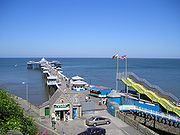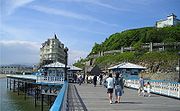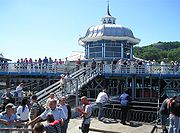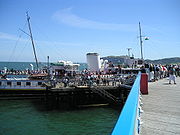
Llandudno Pier
Encyclopedia





Pier
A pier is a raised structure, including bridge and building supports and walkways, over water, typically supported by widely spread piles or pillars...
in the seaside resort
Seaside resort
A seaside resort is a resort, or resort town, located on the coast. Where a beach is the primary focus for tourists, it may be called a beach resort.- Overview :...
of Llandudno
Llandudno
Llandudno is a seaside resort and town in Conwy County Borough, Wales. In the 2001 UK census it had a population of 20,090 including that of Penrhyn Bay and Penrhynside, which are within the Llandudno Community...
on the coast of North Wales
North Wales
North Wales is the northernmost unofficial region of Wales. It is bordered to the south by the counties of Ceredigion and Powys in Mid Wales and to the east by the counties of Shropshire in the West Midlands and Cheshire in North West England...
between Bangor
Bangor, Wales
Bangor is a city in Gwynedd, north west Wales, and one of the smallest cities in Britain. It is a university city with a population of 13,725 at the 2001 census, not including around 10,000 students at Bangor University. Including nearby Menai Bridge on Anglesey, which does not however form part of...
and Colwyn Bay
Colwyn Bay
- Demography :Prior to local government reorganisation on 1 April 1974 Colwyn Bay was a municipal borough with a population of c.25,000, but in 1974 this designation disappeared leaving five separate parishes, known as communities in Wales, of which the one bearing the name Colwyn Bay encompassed...
.
At 2295 feet (699.5 m) the pier is the longest in Wales
Wales
Wales is a country that is part of the United Kingdom and the island of Great Britain, bordered by England to its east and the Atlantic Ocean and Irish Sea to its west. It has a population of three million, and a total area of 20,779 km²...
and the fifth longest in England and Wales. A British Tourist Authority report in 1975 said of it: '.... It zooms out of the sea.... in a spectacular Indian Gothic style rather like a Maharajah's palace floating on a lake. Cast iron, brackets of iron lacework, an outstandingly pretty balustrade like an enlarged fish net, ogee roofs curling away to the sky, all add up to a totally pleasurable experience.'
The pier is very unusual in that it has two entrances, one on the promenade at North Parade and the other, the original entrance, on Happy Valley Road. Between the two entrances is the Grand Hotel
Grand Hotel (Llandudno)
The Grand Hotel is a large hotel in Llandudno, Wales, overlooking the Promenade on the North Shore. It is owned by Britannia Hotels.-History:The history of the Grand Hotel begins with the construction of the bathhouse in 1855...
. At the end of the pier is a deep-water landing stage, completely rebuilt for the third time in 1969, which is used by the Isle of Man Steam Packet Company for occasional excursions to Douglas, Isle of Man
Douglas, Isle of Man
right|thumb|250px|Douglas Promenade, which runs nearly the entire length of beachfront in Douglasright|thumb|250px|Sea terminal in DouglasDouglas is the capital and largest town of the Isle of Man, with a population of 26,218 people . It is located at the mouth of the River Douglas, and a sweeping...
, and for an annual visit of the PS Waverley
PS Waverley
PS Waverley is the last seagoing passenger carrying paddle steamer in the world. Built in 1946, she sailed from Craigendoran on the Firth of Clyde to Arrochar on Loch Long until 1973...
or the MV Balmoral preserved steamers. The June 2007 sailings of the Balmoral were rescheduled to start at Menai Bridge Pier, after it emerged that Llandudno Pier's Landing Stage was no longer safe to use.
Llandudno Pier is often chosen for Victorian and Edwardian seaside filming locations and notably for the 2002 TV production of The Forsyte Saga
The Forsyte Saga
The Forsyte Saga is a series of three novels and two interludes published between 1906 and 1921 by John Galsworthy. They chronicle the vicissitudes of the leading members of an upper-middle-class British family, similar to Galsworthy's own...
.
In 2005, the pier was voted "Pier of the Year 2005" by the members of the National Piers Society
National Piers Society
The National Piers Society is a registered charity in the United Kingdom dedicated to promoting and sustaining interest in the preservation and continued enjoyment of seaside piers....
.
History
The pier had its origins in a much shorter pier of just 242 feet (73.8 m) built on 16 wooden piles, opened in 1858 by the St George's Harbour and Railway Company, which had just completed its branch line from Llandudno to ConwyConwy
Conwy is a walled market town and community in Conwy County Borough on the north coast of Wales. The town, which faces Deganwy across the River Conwy, formerly lay in Gwynedd and prior to that in Caernarfonshire. Conwy has a population of 14,208...
via a junction with the Chester and Holyhead Railway
Chester and Holyhead Railway
The Chester and Holyhead Railway was incorporated out of a proposal to link Holyhead, the traditional port for the Irish Mail, with London by way of the existing Chester and Crewe Railway, and what is now the West Coast Main Line...
near the present Llandudno Junction railway station
Llandudno Junction railway station
Llandudno Junction railway station is on the Crewe to Holyhead North Wales Coast Line. The station is managed by Arriva Trains Wales, although Virgin Trains also serves it....
to which the branch was soon diverted. That short pier was built to protect the rights of its owners to a much more ambitious scheme to build a major port in Llandudno Bay. Unfortunately, the pier was severely damaged in the Royal Charter Storm
Royal Charter Storm
The Royal Charter Storm of 25 and 26 October 1859 was considered to be the most severe storm to hit the British Isles in the 19th century, with a total death toll estimated at over 800...
of 25 October 1859, which caused the loss of 223 ships and 800 people in British coastal waters. Although repaired and used for a further 16 years, the pier was too short and could only be used by steam ships at high tide.
The present pier, built for the Llandudno Pier Company by Walter Macfarlane of Glasgow using iron castings from the Glasgow Elmbank foundry, was opened to the public on 1 August 1877. The landwards extension to the same design, still in deep water and also supported on iron columns, was opened in 1884 and a new landing stage was added in 1891. In 1969, the landing stage was totally rebuilt in concrete and steel, which enabled its use by the largest Isle of Man Steamers then in use. The wooden decking has been extensively renewed in recent years, and the superstructure is maintained systematically. The pier is currently owned by Six Piers Ltd, a Blackpool based leisure company.
The Pier Pavilion
In accordance with a tradition that lasted at Llandudno at least until the 1939-45 war, the public were charged for admission to the pier. In return, the promenaders initially received musical entertainment from a band stand at the pier head and a small orchestra was established in 1877. The notable French musician, Jules Rivière was appointed to take charge of that little orchestra in 1887.Rivière soon persuaded the pier management to move the orchestral performances to their massive Pier Pavilion, built on land adjacent to the main entrance from the promenade, and which had opened in September 1886. Rivière's Orchestra at the Llandudno Pier Pavilion was a great success and was quickly trebled in size to symphony proportions. It contributed to the development of that great British summer entertainment, the promenade concert. The young Henry Wood
Henry Wood (conductor)
Sir Henry Joseph Wood, CH was an English conductor best known for his association with London's annual series of promenade concerts, known as the Proms. He conducted them for nearly half a century, introducing hundreds of new works to British audiences...
came to Llandudno to observe the then elderly Rivière at work. The pavilion was destroyed by fire in 1994 and not rebuilt. For the full history see the complete Pier Pavilion
Llandudno Pier Pavilion Theatre
Llandudno Pier Pavilion Theatre was a Victorian seaside theatre in the holiday resort of Llandudno in North Wales, UK.The Directors of the Llandudno Pier Company had successfully opened the new pier in 1878 and were now looking to expand their business to take advantage of Llandudno's growing...
article.
Awards
- Llandudno Pier is a Grade II listed building.
- 2005 — National Piers SocietyNational Piers SocietyThe National Piers Society is a registered charity in the United Kingdom dedicated to promoting and sustaining interest in the preservation and continued enjoyment of seaside piers....
— Pier of the Year

